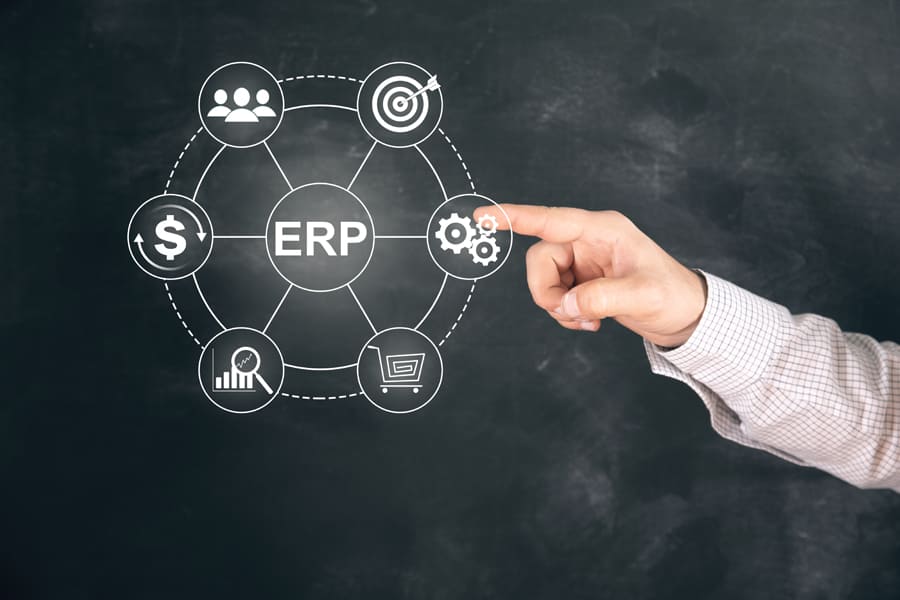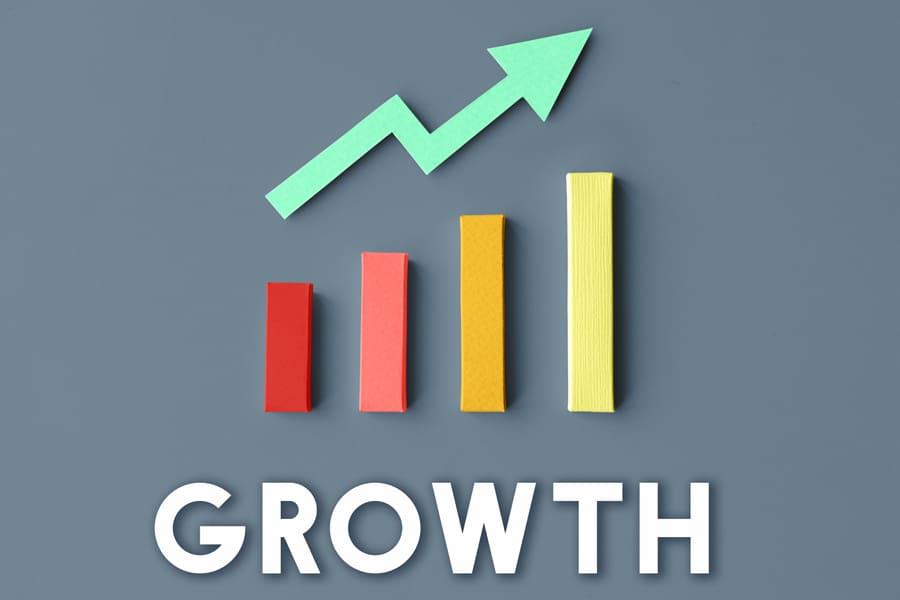An enterprise resource planning system (ERP) is a comprehensive software suite that unites essential business functions such as finance, human resources, manufacturing, supply chain, and sales.
Over 70% of large companies [1] use ERP solutions, with the global market poised to reach $123.4 billion by 2030 [2]. Key sectors like healthcare are projected to expand at a compound annual growth rate (CAGR) of 6.6% by 2028 [3].
There are two main types of ERP systems – – on-premise and cloud ERP.
On-premise systems are managed on the company’s servers and make up about 71.22% [4] of deployment across various industries. Although it gives your business complete control, on-premise systems can be pretty expensive.
Cloud ERP solutions are hosted in the cloud [5] and can be accessed from anywhere with an internet connection. The cloud valuation stood at around $39 billion [6] in 2019 and has experienced a 42% surge from 2013 [7], with 60% of companies [8] moving toward private cloud solutions.
Cloud ERP systems are typically less expensive to implement, but they require a reliable internet connection and may have security concerns.
Although most systems are usually categorized as cloud or on-premise, at least 55% of retail users [9] deploy a hybrid system that combines cloud and on-premise features.
About 92% of enterprises [10] have a multi-cloud strategy or plan to have one. Moreover, 93% of businesses [11] customize their software depending on the specific uses, with 48% [12] choosing moderate customization.
ERP systems provide a unified view of data across all departments rather than multiple systems. We will list the benefits of ERP below.

Enhancing operational efficiency
ERP systems can help businesses improve their operational efficiency in several ways.
Those include:
- Streamlining and automating business processes: Business systems can use ERP software to automate repetitive tasks, such as order processing and invoicing. This can free up employees to focus on more strategic and value-added activities. For instance, manufacturing businesses that implement ERP enterprise systems achieve reduced operational costs by 23% [13].
- Improving data accuracy and visibility: You can use modern ERP software as a single source of truth for all business data. It also offers access control and authentication features that ultimately reduce errors to improve decision-making and operational efficiency.
- Enabling visibility into business performance: ERP software provides real-time visibility into key business metrics, such as order status and customer satisfaction. 95% of companies [14] report an improvement in business processes after ERP implementation. This information can help detect and solve possible problems in advance and help business owners make better decisions.
ERP systems offer a comprehensive solution to enhance operational efficiency, from streamlining processes to improving data accuracy and enabling real-time visibility. By implementing these solutions, businesses can unlock significant cost savings and empower their workforce.
Cost savings and financial management
Over 46% of businesses [15] adopt ERP systems to streamline expenses throughout the supply chain. The software offers multiple ways for businesses to save money and enhance financial management.
They do so by:
- Reducing operational costs: By improving transparency and integrating processes, organizations can utilize these systems to reduce operational costs. For example, the software can assist manufacturing firms in minimizing wastage and boosting production efficiency.
- Improving financial analysis and planning: Finance represents the largest segment of the ERP sector, accounting for over 25% of the market [16] in 2022. This provides businesses with a unified source that captures all financial data, facilitating more robust financial analysis and planning. For instance, the software enables companies to continuously monitor their expenses, identify areas for savings, and generate reliable and timely financial reports.
- Better cash flow management: ERP systems enable real-time cash flow tracking, ensuring timely payments and sufficient available cash to meet recurring obligations.
ERP business software can help you save money and manage finances better by helping with planning and cash flow management. You can pay your suppliers on time, maintain a healthy cash position, and make smarter decisions for your business.
Better customer service and satisfaction
ERP systems can help businesses better understand their customers and provide them with the best customer experience. This can lead to increased customer satisfaction and profitability in several ways.

We will list them below:
- Improved order fulfilment: Businesses can use ERP to streamline the order processing and fulfilment process.
- Enhanced customer support: ERP solutions give customer service representatives all relevant customer information, such as order history, product information, and support tickets. This can help them resolve customer issues more quickly and efficiently.
- Increased customer loyalty: Great order fulfilment and customer support keep customers happy and satisfied. This can lead to repeat business and positive referrals.
Acquiring ERP solutions isn’t just about managing operations — it’s also about ensuring happy and satisfied customers who keep returning and recommending your business to others. You can create better relationships with your customers, which can lead to more loyal customers and better sales in the long run.
Inventory management and supply chain optimization
ERP systems help businesses manage their inventory and supply chain operations more efficiently. They give a complete view of all important business data in one place.
For example, about 47% of manufacturing companies [7] use ERP systems to improve their inventory management. They can keep track of how much product they have in stock, customer orders, and shipping schedules.
Businesses with a single view of all this data can understand their supply chains and make informed business decisions on supply chain management. ERP implementation can reduce inventory costs by 25% to 30% [16] and optimize the supply chain.
It does this through several improvements:
- Improved visibility: Real-time data visibility into inventory levels across all warehouses and distribution centres can help businesses optimize their inventory levels to meet customer demand.
- Better forecasting: The software can use historical data and machine learning to forecast customer demand. This helps businesses ensure they have the right inventory levels in the right place at the right time.
- Improved planning: Businesses can optimize their supply chains, including sourcing materials, scheduling production, and managing transportation.
- Lowering costs: Reducing inventory levels, forecasting demands, and optimizing supply chain planning can reduce the costs associated with shortages, overstocking, and obsolescence.
- Ensuring that customers acquire the right products: With ERP software, your business has the right products in stock, which enhances customer satisfaction.
ERP software lets you track your inventory levels and their flow. It empowers you to streamline supply chains, reduce costs, and ultimately increase customer satisfaction.
Business intelligence and informed decision-making
ERP systems provide businesses with a unified system for all of their data. Businesses can then use this data to create business intelligence reports and dashboards to identify patterns, trends, and opportunities.
This helps them better understand their performance, and about 49% [17] of businesses see an improvement after implementation, while only 5% say they don’t see an improvement. ERP systems can help in business intelligence and informed decision-making in the following ways.
Analyzing data and reporting
ERP solutions provide a foundation for data-driven solutions and swift market response.
They enhance data analytics and reporting for your business by storing all business data in a single centralized system, and over 66% [18] of companies report that their systems have increased efficiency. This simplifies data conversion and analysis for different departments like finance, accounting, production, sales, and customer relationship management (CRM).
Most ERP applications include reporting modules that let you create your own reports and charts tailored to your business. You can select specific, accurate data points and key performance indicators for your organization to track what is important to you and take well-informed actions.
Business process visibility
ERP systems consolidate all of the data on your business, from sales to finance and inventory to production, in a single location. This gives you a holistic picture of every process and activity so you can spot any issues and continually monitor progress.
These tools are also a source of critical information about your processes via charts, reports, and analytics that let you view trends and spot patterns. This makes it easier to adapt your operations to meet changing demands.
Predictive analysis and strategic planning
ERP systems gather a wealth of data from various aspects of your operations — sales, inventory, finances, and more. By analyzing this data, businesses can then generate predictive analytics reports for improved demand forecasting.
They also provide a solid foundation for strategic planning. With the insights derived from predictive analysis, businesses can chart a course for the future. Companies can set long-term goals, plan resource allocation, and make decisions based on a more comprehensive understanding of their business environment.
Scalability and growth
As your business grows, you can add additional modules or users to your ERP system to meet your changing needs. These modules can be configured to support different business models and processes.

ERP software can help with scalability and growth in the following ways:
- Adapting to business growth: About 25% of finance managers [19] prioritize capability when choosing an ERP solution. Only 3% of businesses [19] use out-of-the-box systems, and most systems are highly configurable, so companies can customize them to meet their specific needs.
- Flexible deployment options: A small business can deploy a cloud ERP system to save on upfront costs, while a large enterprise can opt for an on-premise system to maintain control over its data.
ERP systems act as your adaptable partner on the journey of business growth, allowing you to tailor your system to evolving needs. With various deployment options, you can choose the best fit for your business size and requirements.
Compliance and risk management
ERP systems help your business to navigate regulatory requirements. They assist in adhering to regulations, including financial reporting requirements, industry-specific rules, and data privacy.
The software can improve compliance and risk management in the following ways:
- Regulatory compliance: ERP implementation helps businesses comply with several regulations, be it financial, industry-specific, or government mandates. It also generates the necessary reports.
- Enhanced data security: Businesses can bolster their security using ERP features like dedicated data security to prevent unauthorized access, usage, disclosure, disruption, modification, or destruction.
- Risk mitigation and auditing: Some key functionalities include identifying and assessing risks, formulating strategies to mitigate these risks, tracking the execution of these strategies, and automating the auditing process.
ERP platforms ensure your business complies with various regulations, keep your data secure, and assist in risk management and auditing. With these solutions, your business can stay compliant, protect its data, and reduce potential risks.
Challenges and considerations
While ERP systems offer numerous benefits, including increased efficiency, productivity, and informed decision-making, their implementation can be a complex journey. Over 85% of companies [12] expect full implementation in less than a year, but this can bring about a set of common challenges.
Upfront Costs
Installation costs between $150,000 and $750,000 [1]. The acquisition and implementation of these systems can be costly, especially for larger businesses, and over 45% of installations [20] go over budget.
The cost of a system is substantially tied to the acquisition of new technology, and approximately 50% of companies [21] plan to acquire new systems.
Choosing a subscription-based plan might seem cheaper initially, but over eight years [7], it costs the same as buying a perpetual license all at once.
Complexity
Only 8% of IT managers [22] say their new system is user-friendly, and about 75% of implementations fail [23]. Many systems are intricate software solutions demanding meticulous planning and execution. Implementation can be a time-consuming process, and around 90% of companies [24] use consultants for project management.
Change management
About 50% of business owners [7] initiate the software purchase, but 82% of staff [25] initially resist new systems. Most implementations can involve significant change for employees, leading to resistance. And in many cases, only about 26% of workers [26] use the platform.
Thus, it’s essential to communicate with employees about the expected changes and provide them with training on the new system.
Such training should include:
- Data migration: Moving huge amounts of data from existing systems into a new one is not easy and might even increase project duration by 30% [7]. It’s important to have a plan for data migration and to test the data thoroughly before migrating it to the new system.
- Integration: 41% of organizations [1] using ERP software have integrated it with their customer relationship management and disparate systems. This can be a complex and challenging process, but integrating all of your systems gives you a single view of your business data.
ERP implementation has its fair share of challenges. From the considerable upfront costs and navigating complex systems to managing data migration and system integration, it’s a journey that requires thoughtful planning and management. It’s essential to mitigate these challenges with a strategic plan to ensure a smoother transition and maximize the advantages they offer.
Costs and return on investment (ROI) analysis
The initial set-up costs vary significantly depending on the size and complexity of your business, your ERP system’s features, and how it is implemented — on your servers, in the cloud, or as a hybrid option.
Usually, a modern ERP system pays itself off in about 16 months with an ROI of about 200% for most businesses [27], and the average budget per user for a project is about $9,000 [28].
Conducting a thorough ROI analysis is crucial before considering ERP software solutions. The analysis should assess the ERP system benefits, expenses, and risks.
Strategies for successful implementation
A strategic ERP implementation should align the ERP system with the company’s overarching business goals and objectives. This ensures that the software becomes a valuable tool for driving the organization forward, as 53% of IT managers [29] consider ERP implementation a top priority.

Some strategies for successful ERP implementation include:
- Choosing the right ERP system for your business: Ensure that the system aligns with the size and requirements of your business. Consider your budget, industry, and specific business needs during selection.
- Developing a detailed implementation plan: ERP software selection usually takes around 17 weeks [30], yet only 49% of companies [7] implement it within that time frame. Your implementation plan should outline timelines, milestones, and available resources and proactively address potential challenges.
- Communicating with employees: Keeping your employees in the loop is key. They’re part of the transition, and their buy-in and understanding are critical for success. So, maintain clear and open communication channels throughout the implementation journey.
- Training employees on the ERP system: Train employees to ensure that they understand the technical aspects and can easily integrate the system into their daily workflows.
- Testing the system thoroughly before going live: Carry out routine tests to identify and fix any problems before they impact your business operations, as many businesses deal with inflexible software.
- Providing ongoing support to users: Provide ongoing support to users after the system has been implemented. This will help to ensure that they can resolve most problems.
Choosing the right system and creating a detailed plan give you a better chance of achieving a smoother transition.
With these strategies, your business can unlock the full potential of ERP systems, making your operations more efficient and effective for long-term success.
Data sources
- 21 ERP Software Statistics That Every Business Should Know by Sage Software Solutions Pvt Ltd
- ERP Software Market Size Worth $123.41 Billion by 2030 by Bloomberg
- Healthcare ERP Market Size, Share & Trends Analysis Report By Function (Finance And Billing, Inventory And Material Management), By Deployment (On-premises, Cloud), By Region, And Segment Forecasts, 2021 – 2028 by Grand View Research
- ERP Software Market to Hit $117.69 Billion by 2030, Growing at a CAGR of 9.88% by GlobeNewswire
- Best Cloud ERP Software (November 2023) by Forbes Advisor
- 90 Vital ERP Software Statistics 2023: Data Analysis & Market Share by FinancesOnline
- 50 ERP Statistics by Software Connect
- Why are so many companies moving to a Cloud ERP? By Unit4
- The Cloud ERP Market to Grow at 10 Percent CAGR by 2025 by Beroe Inc
- Why Enterprises Are Bringing Their Workloads to Multi-Cloud Environments by CMSWire
- ERP Market Size & Share Analysis – Growth Trends & Forecasts (2023 – 2028) by Mordor Intelligence
- The Ultimate List of ERP Statistics for 2023 by Founderjar
- Reduce Operational Costs With an ERP by Genius ERP
- Essential ERP Statistics In 2023 by Zipdo
- Real Facts about ERP Implementation by Ultra Consultants
- ERP Software Market Size, Share & Trends Analysis Report By Function (Finance, HR, Supply Chain, Others) by Grand View Research
- 30 ERP Statistics You Need To Know by Concentrus
- ERP Statistics 2023 will be going to provide you with the potential of the industry by Parsimony
- ERP Software Statistics: A Different Way to Manage Data Solutions by Market.us
- 30 ERP Facts Every SMB Executive Should Know in 2022 by ECI Solutions
- ERP Systems for Manufacturing: How it Improves Business Process by Fingent
- Survey shows majority of ERP projects are confused disappointments by Supply Chain
- Gartner: 75% of all ERP projects fail – But why? | Blog by e-School Cloud
- ERP Statistics 2023 by TRUELIST
- 40+ Big ERP Statistics [for Your Buying Decisions] 2023 by Thrivemyway
- What 1,384 ERP projects tell us about selecting ERP (2022 ERP report) by Software Path
- ERP pays for itself–fast by Nucleus Research
- How much does ERP cost? (Free ERP cost and budget guide) by ERP Focus
- IT Priorities 2018: Where senior IT managers plan to spend their budget by ComputerWeekly
- Software by Statista
Frequently asked questions
What is ERP, and why is it significant for businesses?
ERP, or enterprise resource planning, is a comprehensive software suite that integrates core business processes such as finance, human resources, manufacturing, supply chain, and sales into a centralized system.
How does ERP contribute to cost savings and improved financial management?
ERP reduces cost and improves financial management through task automation, process enhancement, and real-time operational expenditure insights. ERP advantages include providing a centralized source of financial data, improving financial analysis, real-time spending tracking, and generating accurate financial reports.
How does ERP impact customer relationships and satisfaction?
ERP solutions enhance customer relationships by integrating customer data into a unified platform. This enables quicker responses to customer inquiries and faster delivery of services.